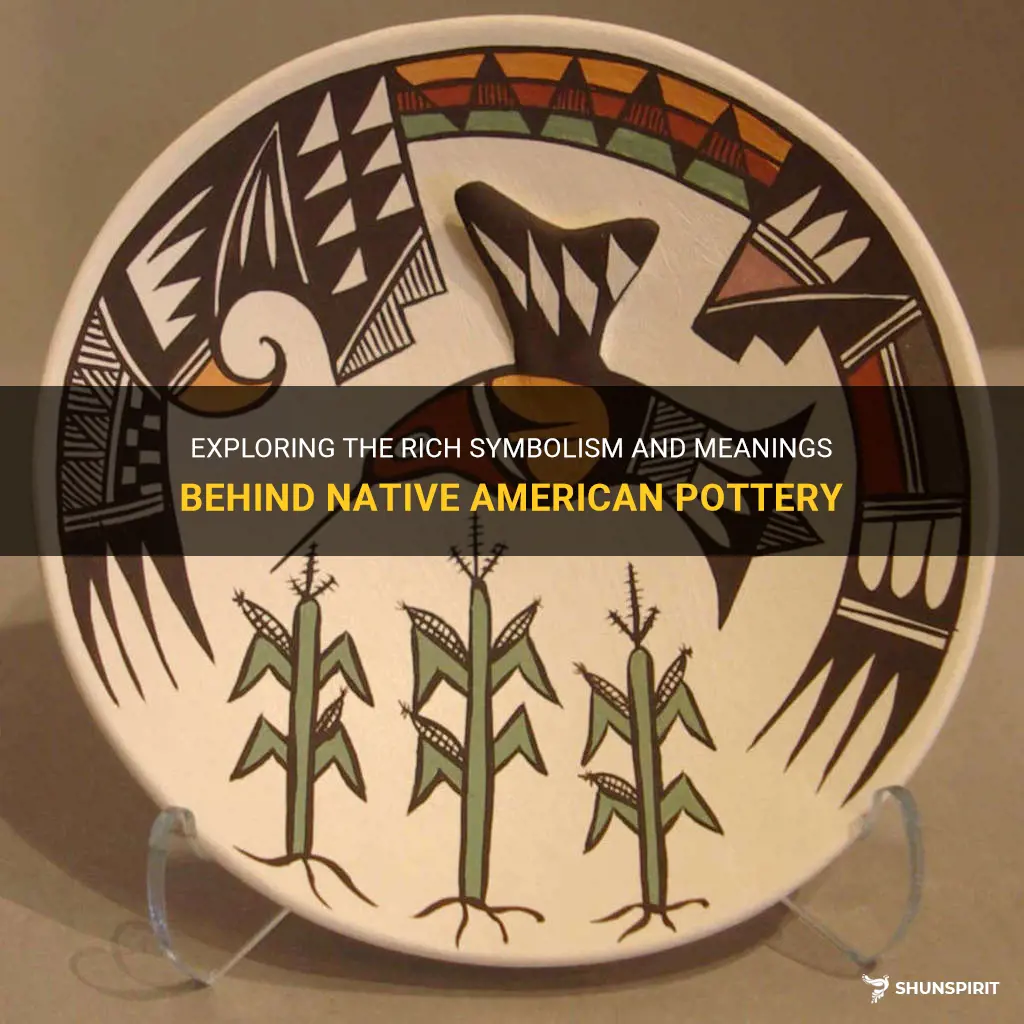
Native American pottery is much more than just beautiful art. It is a gateway into the rich cultural heritage and profound spiritual beliefs of indigenous peoples. Each symbol and design adorning a pottery piece has a deep meaning, representing a connection to nature, ancestors, and the spiritual realm. These symbols tell stories, honor traditions, and carry the wisdom of generations. Exploring the world of Native American pottery symbols and meanings is like unlocking a treasure trove of ancient wisdom and timeless beauty.
What You'll Learn
- What are some common symbols used in Native American pottery and what do they represent?
- How do Native American pottery symbols and meanings vary across different tribes and regions?
- Are there any specific colors or patterns commonly used in Native American pottery and do they have specific meanings?
- How have Native American pottery symbols and meanings evolved over time?
- Are there any cultural or spiritual beliefs associated with the creation and use of Native American pottery in relation to symbols and meanings?

What are some common symbols used in Native American pottery and what do they represent?
Native American pottery is known for its intricate designs and rich symbolism. The various symbols used in Native American pottery represent important cultural and spiritual beliefs. Here are some common symbols found in Native American pottery and their meanings:
- The Sun - The sun symbolizes life, growth, and warmth. It is often depicted as a circle with rays emanating from it, representing the sun's power and energy. The sun is considered a source of light and inspiration in many Native American cultures.
- The Thunderbird - The Thunderbird is a powerful symbol in Native American pottery. It represents strength, protection, and supernatural powers. The Thunderbird is believed to control the rain, thunder, and lightning. It is often depicted with outstretched wings and sharp claws.
- The Kokopelli - The Kokopelli is a fertility deity often depicted as a humpbacked flute player. It is a symbol of music, fertility, and happiness. The Kokopelli is believed to bring good luck and prosperity. Its image can often be found on pottery used for traditional ceremonies and celebrations.
- The Spiral - The spiral is a common symbol used in Native American pottery and represents life's journey. It represents growth, transformation, and harmony with the natural world. The spiral is often depicted as a curved line that gradually expands or contracts, symbolizing the cyclical nature of life.
- The Feather - Feathers are important symbols in Native American culture. They represent spiritual power, strength, and protection. The feather is often depicted as part of a headdress or as a standalone symbol on pottery. The colors and patterns of the feathers also carry specific meanings.
- The Bear - The bear is a symbol of strength, courage, and wisdom in many Native American cultures. It is often depicted as a powerful creature with sharp claws and a fierce gaze. The bear is believed to possess healing powers and is associated with the natural world and its cycles.
- The Water - Water is a vital element in Native American culture and is often represented in pottery. It symbolizes purification, life, and renewal. Water is considered a sacred element and is used in various healing rituals and ceremonies.
- The Corn - Corn is a staple food in many Native American cultures and is often depicted in pottery. It symbolizes sustenance, fertility, and abundance. Corn is believed to be a gift from the spirits and is used in various ceremonies and celebrations.
These symbols and their meanings may vary slightly across different Native American tribes and regions. However, they all share a common thread of representing important cultural and spiritual beliefs within the Native American community.
The Ultimate Guide to Mitsubishi Shogun Dashboard Symbols and Meanings
You may want to see also

How do Native American pottery symbols and meanings vary across different tribes and regions?
Native American pottery has a rich tradition of symbolism and meaning. Across different tribes and regions, these symbols can vary, reflecting the cultural and artistic diversity of Native American communities. In this article, we will explore how Native American pottery symbols and meanings differ across tribes and regions.
One of the most well-known pottery styles in Native American culture is the Acoma pottery from the Acoma Pueblo in New Mexico. Acoma pottery often features intricate geometric patterns, such as lines, dots, and spirals. These symbols can represent elements of nature, such as rain or clouds, or spiritual concepts, like harmony and balance. The patterns are often hand-painted using black and white pigments, creating a striking contrast.
In the Southwest, another famous pottery tradition is the Hopi pottery. Hopi pottery is characterized by its intricate designs and use of natural colors, such as red, white, and orange. The symbols used in Hopi pottery are deeply rooted in their religious beliefs and reflect their connection to the land and nature. Common symbols include corn, rain clouds, and katsinas (spiritual beings). These symbols convey messages of fertility, abundance, and spirituality.
Moving further north, the pottery symbols of the Navajo Nation showcase a different style. Navajo pottery is known for its smooth and burnished surface, often adorned with simple yet striking designs. The symbols used in Navajo pottery often depict animals, such as deer, birds, and lizards. These animals hold a significant place in Navajo mythology and represent various qualities, like strength, adaptability, and spiritual guidance. The pottery symbols also communicate stories and legends, preserving the history and traditions of the Navajo people.
In the eastern part of the United States, the pottery of the Cherokee Nation showcases unique symbols and meanings. Cherokee pottery is characterized by its intricate carvings and use of earth tones, such as brown and tan. The symbols used in Cherokee pottery often depict animals that hold cultural significance, such as the bear, turtle, and wolf. Each animal symbolizes different qualities and has specific meanings in Cherokee culture. For example, the bear is associated with strength and courage, while the turtle represents wisdom and long life.
Across different tribes and regions, Native American pottery symbols and meanings vary based on their cultural traditions, beliefs, and environment. While some symbols may have similar representations across tribes, such as the use of animals or nature elements, each tribe puts its unique spin on these symbols, reflecting their distinct traditions and stories. Native American pottery is not only a form of art but also a way to preserve and transmit cultural knowledge and spirituality from one generation to another.
The Hidden Meanings Behind the Choku Rei Symbol
You may want to see also

Are there any specific colors or patterns commonly used in Native American pottery and do they have specific meanings?
Native American pottery is known for its vibrant colors and intricate patterns. Each tribe has its own distinct style and symbolism that is reflected in their pottery. The use of colors and patterns in Native American pottery goes beyond mere aesthetics; they hold deep cultural and spiritual meanings.
Colors play a significant role in Native American pottery. Some of the commonly used colors include black, white, red, yellow, and blue. These colors are often derived from natural minerals and sources. For example, black is achieved by firing the pottery in a reducing atmosphere, and red is obtained from iron oxide or red clay.
The choice of colors varies among tribes, and each color carries its own symbolic meaning. Black usually symbolizes power and strength. It is often used to depict night, time of reflection, and spiritual matters. White represents purity, clarity, and spirituality. It is commonly used to express the concept of light and enlightenment.
Red is associated with life, energy, and vitality. It symbolizes the blood of the earth and is often used to depict the sun and life-giving forces. Yellow signifies knowledge, wisdom, and faith. It is often used to represent the sun, corn, and enlightenment.
Blue is commonly associated with the sky, water, and spiritual realms. It symbolizes peace, tranquility, and harmony. It is often used to convey a sense of spirituality and connection to the divine.
In addition to colors, patterns are also an important element in Native American pottery. These patterns are often inspired by nature, animals, and geometric shapes. Some common patterns include bear paw, feather, lightning, and water designs.
Each pattern has its own significance and varies among different tribes. For example, the bear paw symbolizes strength, protection, and leadership. Feathers are often associated with birds, freedom, and spirituality. The lightning pattern represents power, energy, and transformation. Water designs symbolize life, purification, and renewal.
The combination of colors and patterns in Native American pottery tells a story and reflects the spiritual beliefs and values of the tribe. The pottery serves as a way to preserve and pass on cultural knowledge from one generation to another.
In conclusion, Native American pottery is characterized by its vibrant colors and intricate patterns. These colors, such as black, white, red, yellow, and blue, hold specific symbolic meanings. The patterns, inspired by nature and geometric shapes, also carry deep cultural significance. The use of colors and patterns in Native American pottery is a way to express the tribe's spiritual beliefs and preserve their cultural heritage.
The Enigmatic Language of Angelic Symbols: Decoding the Meanings Behind Heavenly Signs
You may want to see also

How have Native American pottery symbols and meanings evolved over time?
Native American pottery has a rich history that dates back thousands of years. Throughout this time, symbolism has played an important role in the creation and design of pottery. These symbols not only hold deep cultural and spiritual meanings, but they have also evolved and changed over time.
The earliest known Native American pottery dates back to around 1500 BCE and was created by the Ancestral Pueblo people of the American Southwest. The pottery of this period featured simple geometric designs and motifs, often representing the natural world and animals. These designs were created using engraved or incised techniques or by painting them with mineral pigments.
As time went on, Native American pottery symbolism became more intricate and varied. Different tribes and regions developed their own unique symbols and designs. For example, the Navajo people of the Southwest incorporated symbols of fertility, rain, and protection into their pottery. The Zuni people of New Mexico used symbols to represent their beliefs about the world around them, such as the sun, animals, and sacred mountains.
Symbolism in Native American pottery not only represented the spiritual beliefs of the people but also served practical purposes. For example, many pottery vessels were decorated with symbols that represented the intended use of the vessel. This could include symbols for water, food, or storage. These symbols helped to communicate and convey the purpose of the vessel to others.
The meanings behind Native American pottery symbols have also evolved over time. With the arrival of European settlers and the forced relocation of Native American tribes, traditional pottery making practices and designs underwent significant changes. Some symbols and motifs were lost, while others were altered or adapted to reflect the changing cultural and social landscape.
Today, Native American pottery continues to be created and celebrated. Many contemporary Native American potters are incorporating traditional symbols and meanings into their work, while also bringing new ideas and styles to the art form. The symbolism in modern Native American pottery reflects a blending of traditional and contemporary influences, reflecting the ongoing evolution of Native American culture.
In conclusion, Native American pottery symbols and meanings have evolved over time. From simple geometric designs to intricate symbols representing spiritual beliefs and the natural world, these symbols have played an important role in Native American culture. As times have changed, so too have the symbols and their meanings, reflecting the ongoing evolution and adaptation of Native American pottery. Today, Native American pottery continues to be a vibrant and important art form, carrying on the rich tradition of symbolism and meaning.
Decoding the Meaning of the Fire Symbol on Fitbit: What Does it Signify?
You may want to see also

Are there any cultural or spiritual beliefs associated with the creation and use of Native American pottery in relation to symbols and meanings?
Native American pottery has a rich history that dates back thousands of years. The creation and use of pottery in Native American culture is deeply rooted in their spiritual and cultural beliefs. Symbols and meanings are an integral part of this art form, and they hold deep significance for the Native American people.
One of the most common symbols found in Native American pottery is the spiral. The spiral symbolizes the cycle of life and is often associated with the sun. It represents the eternal cycle of birth, growth, death, and rebirth. The spiral is also believed to bring energy and balance to the pot and its owner.
Another important symbol is the rain cloud. The rain cloud represents fertility and abundance, and it is often used in pottery designs to bring rain and ensure a good harvest. The rain cloud is also associated with prayers for good fortune and blessings.
Animals are also a common theme in Native American pottery. Each animal has its own symbolic meaning. For example, the eagle represents strength, courage, and freedom, while the turtle symbolizes longevity and wisdom. The bear is associated with strength, protection, and healing, and the wolf represents loyalty, intelligence, and leadership. These animal symbols are often incorporated into pottery designs to invoke the qualities of the animals and bring their energy into the pot.
Feathers are another significant symbol in Native American pottery. Feathers are seen as a connection to the spiritual realm and are often used to represent communication with the gods. They are also a symbol of protection, as they were believed to protect the wearer from harm.
Colors also play a vital role in Native American pottery symbolism. Different colors have different meanings and are often used to convey specific messages. For example, red represents war, yellow symbolizes the sun and light, black is associated with power and strength, and white represents purity and spirituality.
The creation and use of pottery in Native American culture are deeply ingrained in their spiritual and cultural beliefs. Symbols and meanings hold profound significance, and eachpiece of pottery tells a story. Native American pottery is not just a functional item but a spiritual and artistic expression of their beliefs and way of life. It serves as a powerful link between past and present, connecting the Native American people to their ancestors and their cultural heritage.
Exploring the Meaning Behind Cadillac SRX Dashboard Symbols
You may want to see also
Frequently asked questions
The symbols found on Native American pottery vary depending on the tribe and region, but they often represent important aspects of tribal life, such as animals, nature, and religious beliefs. For example, a thunderbird symbol may represent power or strength, while a turtle symbolizes wisdom and protection.
Native American pottery symbols and meanings were traditionally passed down through oral storytelling and apprenticeship. Elders in the tribe would teach the younger generations about the symbolism behind each design, ensuring that the knowledge was preserved and continued to be represented in pottery for future generations.
Yes, colors used in Native American pottery can have specific meanings. For example, red may symbolize life force or vitality, while black may represent death or the spirit world. The use of certain colors in combination with specific symbols can further enhance the intended meaning of the pottery.
To learn more about Native American pottery symbols and meanings, one can visit museums or cultural centers that showcase Native American art. Additionally, there are books and online resources available that provide in-depth information about different Native American tribes and their pottery traditions. Engaging with Native American artists and experts in the field can also be a valuable way to gain knowledge and understanding of these symbols and meanings.







